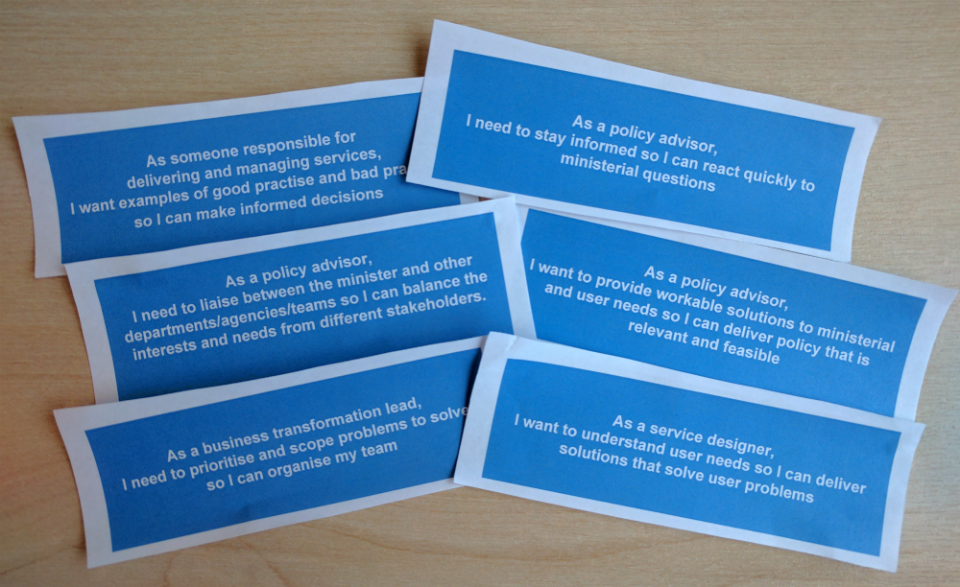
From a user’s point of view, the definition of a government service is simple: it helps you do something.
But how services are designed and made across government is far less simple. So we carried out a user research project to find out how GDS can better support people at different stages of service design and delivery.
GDS already offers a number of things that help service teams in different ways. For example the Service Manual gives guidance on creating better services. Teams can use common components such as GOV.UK Pay and GOV.UK Verify to build services more easily.
But we wanted to test our assumptions and see if there was any other support we could offer.
Over 6 weeks last summer, I visited 6 government departments and one agency to explore how services are made, from conception to delivery. I spoke to 50 people, including policy advisors, service managers, finance controllers and designers.
Here’s what I found, and what GDS is going to do about it.
Stages of development
For the research I prepared a hypothesis of the service design journey that broke it down into 5 stages:
Stage 1: Decide to do something
Stage 2: Shape the thing
Stage 3: Write business case (part of the process to get funding and approval)
Stage 4: (Re)design service
Stage 5: Make and run service
Using this hypothesis as my starting point, I shared it with people I visited in departments, asking a set of common questions that included:
- how closely do the 5 stages mirror your own experiences?
- when do you or members of your team get involved?
- where are the pain points?
- who else gets involved at each stage?
2 separate cycles
The research confirmed a few things. It showed that creating government services is a very complex process. It can involve lots of steps and lots of people. And the process varies hugely in each department and from case to case.
One thing that came up across departments is that the process for creating and launching new services can broadly be broken down into 2 cycles: the policy cycle and the delivery cycle.

The activities within these cycles can vary. The policy cycle may contain activities like deciding to do something and then shaping that thing. The delivery cycle may contain activities around designing and making services. The important thing is that there can be little or no relationship between one cycle and another.
One service manager I met said: “Most departments have a really distinct policy profession, a really distinct analytical profession, a legal profession. And then we’ve got digital technology in a separate place.”
Breaking down the barriers
The research found that there is a clear recognition across government that there should be more collaboration between policy and digital to break down the barriers between these cycles. And there is an increasing momentum to make this happen.
Home Office Digital Head of Service Design Kate Tarling recently wrote a blog post titled What do service designers do?. In it, she said everyone involved in creating government services needs to be “thinking about the entire end-to-end service and wider context, not just a small part of it”.
As one department’s Chief Digital Officer told me: “It’s not enough for a service designer just to talk service design, the service designer has to be able to start to talk policy and policy has to be able to start to talk service design.”
And in the words of a policy advisor: “There needs to be more trust between policy teams and delivery teams, because if you walk in their shoes you see they’re great people working hard. Just having those different perspectives means you can get a lot of mistrust, which is why you need to mature the relationship.”
How GDS can help
This research has identified areas where GDS can play a part in helping to increase understanding of the skills and roles of each other throughout the service process. And how we can work with departments and other organisations who are also focusing on this area.
One way we think we can help is by facilitating cross-government service networks. By this we mean networks of people who might be in different roles and different departments but who are all working on meeting the same user need. For example, users who have mobility issues and want to apply for a parking permit. Or users who want to start a business.
We took this concept to the most recent Transforming Together event and got some great feedback. We’re now planning to work with departments to develop this and other ideas, to help the collaboration that is already happening and to support departments in their mission to make better government services.
We’ll be sharing more on this soon.
Follow GDS on Twitter, and don’t forget to sign up for email alerts.

